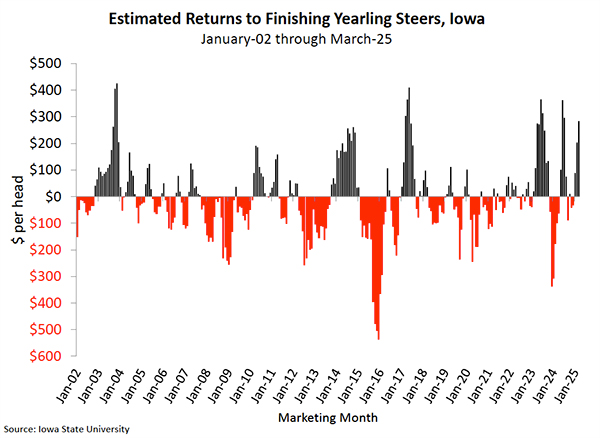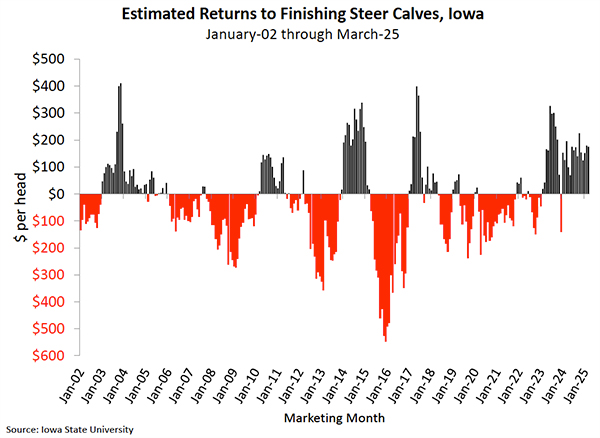Growing Beef Newsletter
May 2025, Volume 15, Issue 11
What About Cattle Feeding Profits?
Beth Doran, ISU extension beef specialist
Recently I was asked, "What impact will tariffs have on the beef industry?" A HUGE and complicated question considering the interaction with other commodities, which segment of the beef industry (producer, packer, consumer), and complex international relations. My short answer: "I don’t know."
So, the rest of this article will focus on what I do know based on three Iowa State University Ag Decision Maker publications:
The public is enamored with soaring prices received by feedlot producers and equate this to profitability. For 2024, the average price for Iowa/Minnesota choice steers set a record of $187.92 per live cwt. Thus, a 1500-lb. steer would have grossed $2818, but this is not net profit!
There are three major factors affecting the profitability of cattle feeding - price received for the market-ready animal, purchase price of the feeder animal, and feed cost. In 2024, market and feeder prices were far more important than corn price, which averaged $4.35 per bushel.
Average estimated returns to finishing a steer calf and a yearling steer in Iowa were $149.97 and $3.32 per head, respectively. Profit for finishing steer calves ranged from $69.66 in May to $225.84 in October. The profit for finishing a yearling steer was highly variable, ranging from -$306.99 to $362.49, with seven months in 2024 having negative returns.
Feeder animal price had considerable impact on profitability. Last year, the average Iowa price for medium and large #1 steers weighing 500-600 pounds was $314.65 per cwt. - a record high for the years of 2004-2024. The price of yearling (700-800 lb.) steers also set a record, averaging $263.43 per cwt. Assuming 550 lb. for a calf and 750 lb. for the yearling, this amounts to $1730 and $1975 for each steer.
The difference between gross income for the market steer and the purchase price for the feeder animal needs to cover all other expenses, such as feed, labor, and fixed costs for machinery, equipment, and housing - and hopefully return a profit. But prices flex. Thus, some months there was a profit; other months a loss. This is why feedlot producers are encouraged to utilize risk management tools to limit upside risk in the grain and feeder price and downside risk in live cattle price.
Because feeder steer price is greater than heifer price, cattle feeders may opt to purchase heifers. But there are two important tradeoffs. Their gain and feed efficiency are poorer than steers. And currently, more heifers in Iowa are being retained for breeding – reducing supply and driving up feeder heifer prices. Will this trend hold? Be on watch for the USDA July Cattle Report.


This monthly newsletter is free and provides timely information on topics that matter most to Iowa beef producers. You’re welcome to use information and articles from the newsletter - simply credit Iowa Beef Center.
